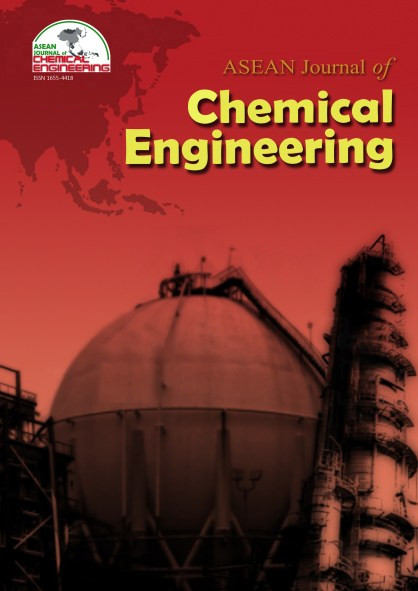CO Digestion for Biogas Production from Tapioca Industrial Wastewater and Septage
Abstract
In this study, a combination of substrate rich carbon with substrate rich nitrogen was carried out. The experiments were conducted in batches process by varying the C/N ratio and types of anaerobic microbial sludge of the cow rumen, anaerobic microbial sludgefrom wastewater treatment plant (WWTP) of septage and anaerobic sludge from WWTP of tapioca industry. Practically in the range of C/N ratio 20-30 didn’t give a significant effect on the biogas production.The C/N 30 ratio provides the most biogas production rate, while the microbe derived from the cow rumen gives the most biogas production rate.Adaptation phase occurred up to 11th days, growth phase occurred lasted until day 24st, stationary phase occurred in the range of day 24th-31st and death phase occurred after day 31st. Biogas yield (by cow rumen) is 1,127 liters per kg of COD removed or 161 liters per kg of COD per day.
References
2. BSNI, (2004a). Analize of CODCr (SNI 06-6989.15-2004). National Standardization Agency of Indonesia Jakarta
3. BSNI, (2004b). Analize of Total Kjeldhal Nitrogen (SNI 19-7030-2004). National Standardization Agency of Indonesia Jakarta
4. BSNI, (2006). Total Organic Carbon-SNI 01-3554-2006, National Standardization Agency of Indonesia Jakarta
5. Deublein D, Steinhauser (2008) A. Biogas from waste and renewable Resource : An Introduction. Wiley-VCH Verlag GmbH & Co. KGaA. Weinheim
6. Erfin,Y. Et al., 2012. Studi Pemanfaatan Feses (Kotoran Manusia) sebagai Bahan Baku Alternatif Energi Terbarukan. Jurnal Ilmu Pengetahuan dan Teknologi, Serpong Tangerang.
7. Fettig J, Pick V, Austermann-Haun U, Blumberg M, Phuoc NV.(2013) Treatment of tapioca starch wastewater by a novel combination of physical and biological processes.Water Sci Technol.68(6):1264-70. doi: 10.2166/wst.2013.354
8. Guerrero L, Omil F, Mondes R, Lema J.M.(1997). Treatement of saline wastewater from fish meal factories in an anaerobic filter under extreme ammonia concentrations. Bioresource Technol. 61(1): 69-78
9. Grady,Jr., C.P.L dan H.C Lim, 1980, Biological Wastewater Treatment, Theory and Application, Marcel Dekker Inc, New York.
10. Gerardi, M.H., 2003. The Microbiology of Anaerobic Digesters,
11. Kayhanian M. (1994) Ammonia inhibition in high solid biogasification : anoverview and practical solution.Environ.Technol. 20 : 355-365
12. Robby, R. et al., 2013. Produksi Biogas dari Limbah Cair Industri Tepung Tapioka dengan Raektor Anaerobik 3.000 Liter Berdistributor. Jurnal Teknik POMITS. Institut Teknologi Sepuluh November, Yogyakarta.
13. Seadi, T. A ed., 2008. Biogas Handbook T. , Denmark: University of Southern Denmark Esbjerg, Niels Bohr Vej 9-10.
14. Zeshan OP, Karthikeyan (2012) .Effect of C/N ratio and ammonia-N accumulation in pilot scale thermophilic dry anaerobic digester . Bioresource Technol. 113 (0): 294-302
Copyright holder for articles is ASEAN Journal of Chemical Engineering. Articles published in ASEAN J. Chem. Eng. are distributed under a Creative Commons Attribution-NonCommercial 4.0 International (CC BY-NC 4.0) license.
Authors agree to transfer all copyright rights in and to the above work to the ASEAN Journal of Chemical Engineering Editorial Board so that the Editorial Board shall have the right to publish the work for non-profit use in any media or form. In return, authors retain: (1) all proprietary rights other than copyright; (2) re-use of all or part of the above paper in their other work; (3) right to reproduce or authorize others to reproduce the above paper for authors’ personal use or for company use if the source and the journal copyright notice is indicated, and if the reproduction is not made for the purpose of sale.



